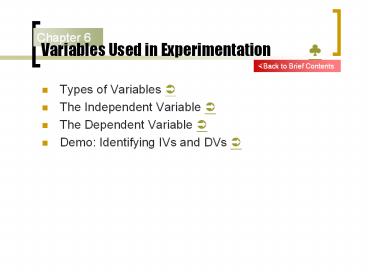Variables Used in Experimentation ? - PowerPoint PPT Presentation
Title:
Variables Used in Experimentation ?
Description:
Variables Used in Experimentation Chapter 6 Back to Brief Contents Types of Variables The Independent Variable The Dependent Variable – PowerPoint PPT presentation
Number of Views:96
Avg rating:3.0/5.0
Title: Variables Used in Experimentation ?
1
Variables Used in Experimentation ?
Chapter 6
?Back to Brief Contents
- Types of Variables ?
- The Independent Variable ?
- The Dependent Variable ?
- Demo Identifying IVs and DVs ?
2
6.1 Types of Variables
?Back to Chapter Contents
- Variable
- Any characteristic or phenomenon that can vary
- across organisms, situations, or environments
- IV-DV-EV
- IV independent variable ???
- DV dependent variable ???
- EV extraneous variable ????
- Discrete vs. Continuous Variables
- Qualitative vs. Quantitative Variables
3
6.2 The Independent Variable
?Back to Chapter Contents
- 6.2.1 Variation
- 6.2.2 Establishing Variation in the IV
- 6.2.3 Constructing the IV
- 6.2.4 Number of IV
4
6.2.1 Variation
?Back to Chapter Contents
- Presence versus Absence
- Fig 6.1
- Amount of a Variable
- Fig 6.2
- Number of levels?
- Type of a Variable
- Fig 6.3
6.2?
5
6.2.2 Establishing Variation in the IV
?Back to Chapter Contents
- Summary Fig 6.4
- Experimental Manipulation
- Manipulation of Instructions
- Dangers inattentive, misinterpretation,
forgetfulness - Manipulation of Events
- Advantages more realistic, more impact
- Individual Difference Manipulation
6.2?
6
6.2.3 Constructing the IV
?Back to Chapter Contents
- Must translate the independent variable into
concrete operational terms - Easy with some IVs
- Drugs
- Length of Time (exposure time)
- Lesion area of the brain
- Hard with others
- Aggression
- Delay of gratification
6.2?
7
6.2.4 Number of IV
?Back to Chapter Contents
- More than one provided additional information
- Theoretically no limit to the number that can be
used - Practically there is a limit
6.2?
8
6.3 The Dependent Variable
?Back to Chapter Contents
- 6.3.0 Introduction
- 6.3.1 Response to be Used as a DV
- 6.3.2 Reducing Participant Error
- 6.3.3 Number of DV
9
6.3.0 The Dependent Variable Introduction
?Back to Chapter Contents
- Definition
- Behavioral variable designed to
- measure the effect of the variation of IV
- Requirement
- Sensitive to, or able to pick up the
effects of IV - (e.g.) split-brain
- Indicate facilitating or inhibiting
- Gender
- Gender-neutral measure
- Responding truthful vs. cooperating
6.3 ?
10
6.3.1 Response to be Used as a DV -1
?Back to Chapter Contents
- Sensitivity to the effect of IV
- Difficulty
- The processes, attributes, or outcome are not
directly observable - Select observation to allow inference back to the
construct - (e.g.) Learning increase in performance
6.3 ?
11
6.3.1 Response to be Used as a DV -2(end)
?Back to Chapter Contents
- How to choose
- Previous experimentation can help
- More commitment demand
- (e.g.) Like liking rating scale
- roommate
6.3 ?
12
6.3.2 Reducing Participant Error
?Back to Chapter Contents
- Disguise the measure guard against cooperation
- Techniques
- 1. Outside the context of the exp.
- 2. Assess behavior of significance to the P
(commitment) - 3. P not realize the DV observed (e.g.
natural beh.) - 4. Embed key items in a larger
questionnaire - 5. Disguise the reason for interest
(hypothesis) - 6. Whoops procedures
- 7. Confederate
- 8. Physiological measure not under
conscious control
6.3 ?
13
6.3.3 Number of DVs -1
?Back to Chapter Contents
- More than one DV used
- (e.g.) Learning frequency amplitude latency
- (e.g.) Attitude questionnaire, observing
behavior, physiological measure - If highly correlated
- Identical measures all but one can be dropped
- If not highly correlated ask why not
- Unreliability
- Not measure the same aspect of the construct
6.3 ?
14
6.3.3 Number of DVs -2(end)
?Back to Chapter Contents
- Analysis Multivariate
- Multidimensional Statistical Analysis
- Multivariate Analysis of Variance (error rate)
6.3 ?
15
Demo Identifying IVs and DVs
?Back to Chapter Contents
- For each of the following research examples,
identify - A. The independent variable
- B. The levels of the independent variable
- C. The method used to manipulate the
independent variable - D. The dependent variable
16
Research Sample ?
?Back to Chapter Contents
- Asch conducted an experiment in which he
wanted to determine if a persons impression of
another person is influenced more by information
received immediately after being introduced or by
information received later in the conversation.
Asch presented a series of positive and negative
adjectives to two groups of individuals. One
group received the positive adjectives first and
the other group received the negative adjectives
first. After reading both lists of adjectives,
each group gave their impression of the
hypothetical person.
17
Research Sample ?
?Back to Chapter Contents
- A study was conducted to determine if men
think the women in a bar get more attractive as
closing time approaches. This was a field study
in which the researcher asked patrons of the bar
to evaluate the attractiveness of various women
in the bar at four different times in the
evening, with the last evaluation being ten
minutes prior to closing.
18
Research Sample ?
?Back to Chapter Contents
- Benbow and Stanley wanted to find out if
gender could be used in trying to differentiate
mathematical ability, so they compared the test
scores on the mathematical portion of the SAT of
9,927 seventh- and eight-grade boys and girls.
In this study they used only the scores of boys
and girls who had the same number of mathematics
courses. When they compared the SAT mathematics
test scores of the boys and girls, they found
that the boys scored significantly higher than
the girls. In addition, they found that more
than 50 percent of the boys scored above 600,
whereas none of the girls scored that high.































